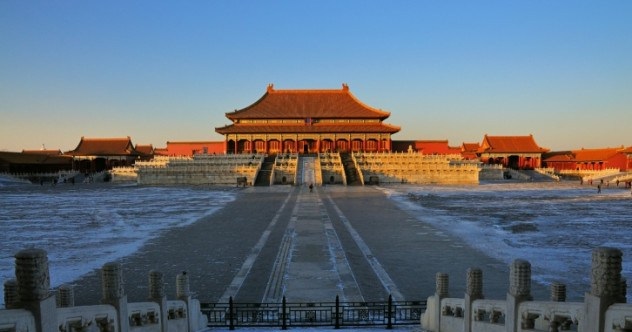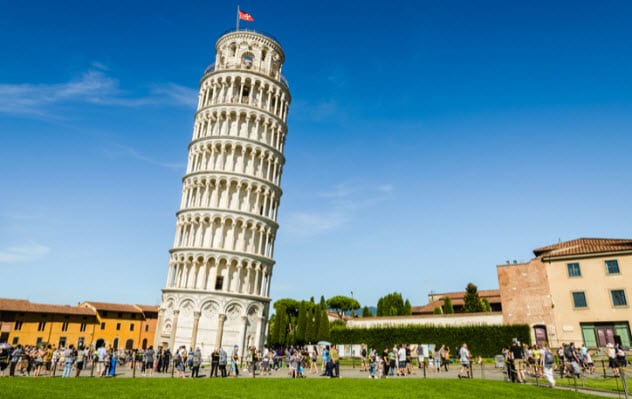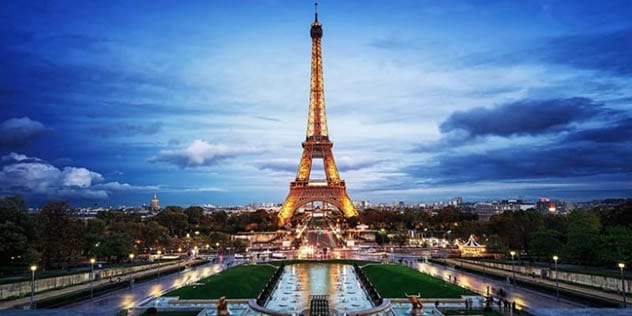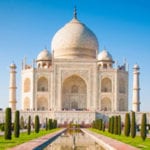 Movies and TV
Movies and TV  Movies and TV
Movies and TV  History
History 10 Momentous Events That Also Occurred on July 4th
 Animals
Animals 10 Times Desperate Animals Asked People for Help… and Got It
 Movies and TV
Movies and TV 10 Movie Flops That Found Their Way to Cult Classic Status
 History
History 10 Things You Never Knew About Presidential First Ladies
 Movies and TV
Movies and TV 10 Zombie Movies That Will Actually Terrify You
 Humans
Humans 10 Times Scientists Were Absolutely Sure… and Absolutely Wrong
 Our World
Our World 10 Pivotal Moments for Life on Earth
 Movies and TV
Movies and TV 10 Most Realistic Medical TV Shows of All Time
 Creepy
Creepy 10 Eerie & Mysterious Ghosts of the Pacific Coast
 Movies and TV
Movies and TV 10 Music Biopics That Actually Got It Right
 History
History 10 Momentous Events That Also Occurred on July 4th
 Animals
Animals 10 Times Desperate Animals Asked People for Help… and Got It
Who's Behind Listverse?

Jamie Frater
Head Editor
Jamie founded Listverse due to an insatiable desire to share fascinating, obscure, and bizarre facts. He has been a guest speaker on numerous national radio and television stations and is a five time published author.
More About Us Movies and TV
Movies and TV 10 Movie Flops That Found Their Way to Cult Classic Status
 History
History 10 Things You Never Knew About Presidential First Ladies
 Movies and TV
Movies and TV 10 Zombie Movies That Will Actually Terrify You
 Humans
Humans 10 Times Scientists Were Absolutely Sure… and Absolutely Wrong
 Our World
Our World 10 Pivotal Moments for Life on Earth
 Movies and TV
Movies and TV 10 Most Realistic Medical TV Shows of All Time
 Creepy
Creepy 10 Eerie & Mysterious Ghosts of the Pacific Coast
Top 10 Most Overrated Tourist Attractions
Gradually and with fingers crossed, we’re starting to get back to normal. Even as the COVID-19 delta variant threatens additional lockdowns, the world is opening back up to travel – and one thing we can all use is a vacation.
But with travel comes a decided downside: the dreaded tourist trap. Here are ten to avoid at otherwise wonderful travel destinations.
Top 10 Iconic Behind-The-Scenes Photos From Hit Movies
10 South Beach (Miami)
The problem with South Beach isn’t that it exists… it’s that it’s the most noteworthy tourist attraction in an absolutely amazing city… and is a garish, trashy trap.
South Beach marries the worst of Florida – gaudy, tacky, violently drunk – with the worst aspects of mass tourism: overpriced, underwhelming restaurants and bars, and ignorant fools thinking they’re getting some sort of authentic South Florida experience.
Locals know precisely how trashy South Beach is; in fact, they sort of like it that way because it keeps tourists away from the city’s best beaches, dining and nightlife. However, the area is now facing a crackdown amid complaints from residents about excessive noise, crowds and, most recently, nightly COVID superspreader events.
If you absolutely must witness this nonsense for yourself, South Beach still has one classy holdover: an upscale seafood restaurant called Joe’s Stone Crab has been an institution since 1913. You’ll pay a premium, but the food is still consistently terrific.
Suggested alternatives: Want a better beach? Try Bill Baggs State Park in Key Biscayne, with a trademark lighthouse and surrey bike rentals under shaded paths. For dining, Calle Ocho in Little Havana features some of the best (and reasonably priced) Cuban food in the world (a personal favorite: El Exquisito, a glorified diner pumping out exemplary Cuban fare). Rainy day? Check in the Wynwood Walls, an artist installment turned hip district with trendy shops and eclectic eateries.
9 Forbidden City (Beijing)

On paper, the Forbidden City has an impressive resume. Lying at the epicenter of the enormous metropolis’ famous ring roads, the 72-hectare area is dotted with imperial residences, ornate gardens and traditional temples.
So named because no one could enter or leave its walled confines without the emperor’s permission, the Forbidden City was initially constructed in the early 15th Century. Serving as the home of Chinese emperors and their households, it was the ceremonial and political center of China for over 500 years. Since 1925, the Forbidden City has been operated by the Palace Museum, and displays an extensive array of artwork and artifacts primarily from the Ming and Qing dynasties. It was declared a World Heritage Site in 1987.
However, the gap between the Forbidden City’s hype and its actuality is, quite literally, yawning. Though there are certainly several items of interest, there are only so many chalices, tapestries and incense burners one can see before everything starts to look the same. While beautiful, it’s an old city that gets old fast – especially for Western visitors, who typically lack the proper intrigue-instilling context behind the mountain of ancient valuables.
Suggested alternative: Beijing is an incredibly fast-changing city. And while the Forbidden City will always be there, its hutongs – aging, often decrepit residential neighborhoods amid a maze of narrow, daunting alleyways – will not. While somewhat voyeuristic, touring these humbler remnants of Beijing’s past can be more fascinating than endless display cases of gilded knickknacks.
8 Checkpoint Charlie (Berlin)
Perhaps no symbol in modern history better exemplified the value of freedom than the Berlin Wall. Following World War II, the city was partitioned between the four major victorious Allies: The US, UK, France and the Soviet Union. And since Berlin sits squarely in eastern Germany, the US, UK and French sectors became an island of Western freedom surrounded by an Iron Curtain.
The result was predictable: East Germans used Berlin as a vehicle to flee to freedom. By 1961, some 3.5 million – about 20% of East Germany’s population – emigrated to West Germany. So the Soviets pulled the ultimate optics don’t: 27 miles of tall, barbed-wire-topped wall. And until its glorious fall in 1989, the most prominent crossing point for foreigners and military personnel was Checkpoint Charlie.
But world-class cities like Berlin evolve. So while the history is fascinating, today Checkpoint Charlie is little more than an intersection with dueling posters showing two soldiers – one American, one Russian – staring at each other from across the now business-as-usual locale. There’s a fairly interesting museum about the Wall’s history, but other than that it’s the expected cheesy souvenir shops and overpriced, underwhelming eateries.
Suggested alternatives: Several bike tours of Berlin visit some of the Wall’s still-standing remnants, a few of which even have original guard towers. Also, a significant stretch of remaining Wall contains more than 100 murals, many dating from the period immediately following the Wall’s official decommission.
7 Old Town Montreal
Many world cities feature charming “old towns.” The Alfama district in Lisbon, Gamla Stan in Stockholm and the narrow streets of Lower Manhattan all have a nostalgic romanticism that, while perhaps a touch touristy in parts, retain the sort of authenticity that make travel so rewarding.
Unfortunately, one of North America’s greatest metropolises, Montreal, has an old city that has wasted several hours of many a tourist’s time. Its old-timey cobblestone streets belie the complete lack of anything worthwhile around its quaint corners. Instead, it’s an endless array of souvenir shops, hustlers offering to draw you as a cartoon, and dumpy cafes selling overpriced, flavorless poutine. The neighborhood is like a protracted lie, dashing hopes for some idealized francophone experience one rueful rue at a time.
Suggested alternatives: Montreal is easily Canada’s most eclectic culinary city. Besides traditional and nouveau French Canadian eateries, the city also has a noteworthy Jewish heritage; a favorite spot for smoked meat sandwiches is Schwartz’s Deli – a rare tourist spot that lives up to the hype.
Montreal also has something fairly unique: a veritable underground city, built in response to the city’s frigid wintertime temperatures. More than 20 miles of walkways connect subway stations, office buildings and housing complexes, and much of it is lined with top-notch shopping and dining. During the summer, Montreal also hosts two world-class annual events: a renowned jazz festival and the “Just for Laughs” comedy-fest.
6 Guinness Brewery (Dublin)
Touring breweries, wineries and distilleries can be immersing ways to discover a region’s culture and cuisine. Everything from wine tasting in Tuscany to whiskey sampling in Scotland to brewery tours in Belgium are inviting, interesting and joyfully intoxicating.
But remove the quaintness from the atmosphere, and what’s left is a mass-market tourist trap. If a winery or distillery’s gift shop is larger than its tasting room, the specialness of an authentic travel experience evaporates along with the angel’s share.
Unfortunately, such is the case with the home of Ireland’s signature beer: Guinness. The thick, frothy concoction is produced at St. James’ Gate Brewery in Dublin; in fact, when the wind is blowing in the right direction, a pleasant barley and hops scent permeates much of the town.
Touring the 18th Century building seems like a very traditional thing to do… until you actually enter the Guinness Storehouse. Inside is a cheesy “museum” whose atrium is tackily shaped like a Guinness pint glass. The entire operation is basically a €25 per person, seven-story endorsement for Guinness, under the guise of telling the history of beermaking.
Suggested alternatives: Plenty of smaller, newer breweries in Dublin offer tours and tastings more intriguing and less expensive. One is Five Lamps, an Irish up and comer. Want to drink somewhere truly historic? Stop by Ireland’s oldest pub, Brazen Head, which has been operating since 1198.
5 Leaning Tower of Pisa

Many a visitor to Florence, Italy has made the fateful decision to book a daytrip 100 kilometers west to the small city of Pisa, population 90,000. There, they looked at an old, slightly askew structure for a few minutes, and then did… what exactly?
People don’t pose for marginally amusing photos featuring the Leaning Tower of Pisa because they’re actually funny; they pose for photos featuring the Leaning Tower of Pisa because there is absolutely nothing else to do in Pisa besides look at a 14th Century belltower with a four-degree tilt.
Want to climb it? Have fun. The handsome price of €17 buys the right to huff and puff up 300 stairs to the top of a building that is… 18 stories tall. Not exactly scraping the clouds up there.
Besides that, there is simply no reason to be in Pisa – especially considering its close-but-not-too-close proximity to Florence. Anyone visiting the region would be remiss to skip Florence and, once there amid unmissable attractions like the Florence Cathedral and its trademark dome, have no need to trek 100 kms to a less impressive place to glimpse a 14th Century construction error.
Suggested alternatives: Far more worthwhile daytrips are available from Florence. For starters, wine tours abound since Florence is in the heart of oenophile Tuscany. Another option is Cinque Terre, an historic five-village cliffside coastal area.
4 Times Square (New York City)
If you’re not going to a play or pick-pocketing a tourist, please remove yourself from Times Square immediately. New York City’s most famous place name is so devoid of anything interesting that a list of “Best Things to Do in Times Square” is headlined by Bryant Park… which isn’t in Times Square.
The cheesy souvenir shops, disgusting chain restaurants and Disneyland-esque cartoon characters peddling five-dollar photo-ops make the area’s peep show and porn theater past look downright sophisticated. Oh, and there’s a guitar-playing guy wearing a cowboy hat, boots and underwear – and nothing else – who’s been skulking around the area since the late 1990s. Can somebody #MeToo this guy already?
Times Square suffers from a classic spillover problem: it’s a neighborhood that has a legitimate purpose – theater – which in turn attracts secondary business catering to the tourists that flock to the theater. Today, though, Times Square’s baseness is eating even the arts, as mass-market musicals that are essentially people dancing to Billy Joel or Green Day limit more deserving productions.
Suggested alternatives: Anything else, with the possible exception of Little Italy. Perhaps a few lesser-known museums? The Museum of the City of New York shows how Manhattan grew from its southern tip up. The Museum of Chinese in America is a great jumping off point to explore Manhattan’s last authentic ethnic neighborhood, Chinatown, while the New York Transit Museum is fittingly housed in an abandoned subway station in downtown Brooklyn.
3 The London Eye (London)
The mid-1990s decision to build what amounts to a permanent state fair installment on the bank of the Thames River probably went something like this:
City official #1: “We’re a world-class city and need to do something to mark the millennium. Any ideas?”
City official #2: (Awkward pause) “Um, how about a big f*cking Ferris wheel?”
City official #1: “Done and done. Here’s £70 million. And go ruin the Big Ben-Westminster Abbey skyline view while you’re at it.”
Originally called the Millennium Wheel, the London Eye, which opened on December 31, 1999, is officially a “cantilevered observation wheel.” In fact, it’s Europe’s largest cantilevered observation deck (how’s THAT for bragging rights?).
Despite basically being a £25-per-person carnival ride in a city of incredible landmarks like the Tower of London and the British Museum, the London Eye – whose myriad detractors call it (what else) the London Eyesore – attracts about three million riders per year. That makes it the single most visited paid attraction in the entire United Kingdom. So either the British are tacky or the tourists are; perhaps they should start serving corndogs and deep-fried Oreos at the ticket booth?
Suggested alternative: Skip the Ferris wheel and go below street level instead – to the Churchill War Rooms. Housing the underground nerve center where the British government directed World War II, as well as the adjacent Churchill Museum, the bunkers recall Londoners at their finest hour.
2 The Blue Mosque (Istanbul)
Judging from its history, the Sultan Ahmet Camil – better known as the Blue Mosque – seems like an itinerary must. The 400-year-old, 13-dome, 8-minaret behemoth has been a UNESCO World Heritage Site since 1985. And since it’s an active house of worship, there’s no admission charge. So kick off those shoes – and cover your heads, ladies – and let’s step inside.
Oh. Huh. It’s just a big carpeted room with Middle Eastern-esque painted walls, some of which are blue.
Unlike the intricate statues and luxuriant ornateness of many Christian (especially Catholic) churches, mosques – even the most famous ones – offer comparably fewer aesthetics. No pictures or busts of prominent Muslims, no grand organ, no gilded chalice holding the alcohol-infused blood of a deity.
Instead, the Blue Mosque is a bunch of windows and patterns. It’s beautiful and interesting for like two minutes. But once you’re done looking around at the reason for its colorful nickname – its 20,000 handmade İznik tiles, a turquoise ceramic, decorated with Turkey’s familiar tulip pattern – it’s just boring. (Note: those truly enamored of Turkish interior design should instead visit the Topkapi Palace Harem.)
Suggested alternative: Assuming you’ve already toured the nearby Hagia Sophia (well worth it), check out the Spice Market, Istanbul’s cavernous covered bazaar dedicated to the region’s culinary delights. Many stalls can vacuum pack spices to survive the plane ride home.
1 The Eiffel Tower (Paris)

The official tagline for Paris’ skeletal skyscraper is “There’s no feeling like it.” And that’s true… if that feeling is abject boredom mixed with regret at wasting several hours better spent elsewhere in the City of Lights. Hell, the ashen ruins of Notre Dame are more appealing.
For starters, a single ticket providing top-level access to the Eiffel Tower is $30. But look! If you buy online, you can skip the line… unless some of the tower’s other 16,000 daily visitors stumbled open this newfangled thing called the Internet. Back of the line, mon ami (P.S., it’s a cliché to say “mon ami” to a Frenchman. Instead say nothing at all!) Rather climb 90 stories of stairs? Be my guest.
But of course, once the waiting is over and you’re up at the top, the view is breathtaking! Only it isn’t. It’s a park surrounded by endless, mostly gray buildings. But hey, just buy a flute of exceptionally overpriced champagne and take in the panoramic ennui.
Like so many other urban “for the view” attractions – the Circle Line boat tour around Manhattan comes to mind – the Eiffel Tower sends tourists over a city they should be diving into. You’re in Paris for God’s sake. There’s better things to do than look at rooftops.
Suggested alternative: The Musee Picasso Paris is among the finest collections of the Spanish artist’s extensive work, housing more than 5,000 paintings, sculptures, drawings, ceramics, prints and engravings. It’s more digestible and less crowded than the Louvre, and offers far better views than the Eiffel Tower.
Top 10 Iconic Places Pictured From Behind








